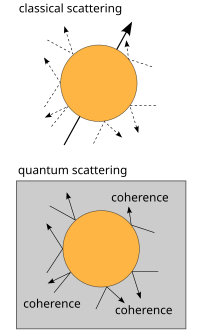
Photo from wikipedia
We assume information is discrete-modulated over coherent states of the single-mode electromagnetic field and transmitted over space quantum channels. In this letter, we provide a comparison of quantum detection with… Click to show full abstract
We assume information is discrete-modulated over coherent states of the single-mode electromagnetic field and transmitted over space quantum channels. In this letter, we provide a comparison of quantum detection with classical detection for communication using on-off keying (OOK) and binary phase shift keying (BPSK) for illustrative system parameters for LEO, MEO and GEO satellites. To do so, we assume an attenuation-only (pure-loss) channel and compute the Shannon capacities for the following detection methods: classical (shot-noise limited) single-photon and coherent detectors as well as optimal quantum hypothesis-testing (Helstrom) detection. As in classical system engineering design, we also obtain theoretical references for comparison, namely, Shannon capacities and Holevo bounds for the ideal Gaussian optical channel. Our results show the ranges of transmitted power and orbital heights for which either classical or quantum detection is optimal, thus providing useful insights into design guidelines and operations of future space communication systems. We also obtain the remarkable result that the BPSK Holevo bound achieves the ultimate quantum capacity of the considered channel.
Journal Title: IEEE Wireless Communications Letters
Year Published: 2023
Link to full text (if available)
Share on Social Media: Sign Up to like & get
recommendations!